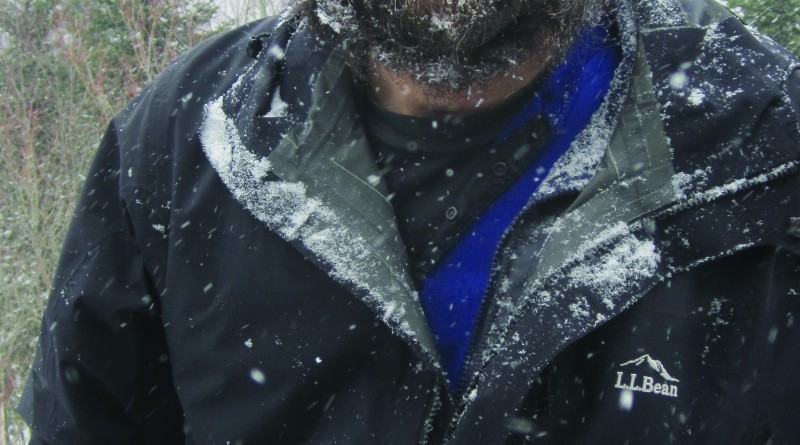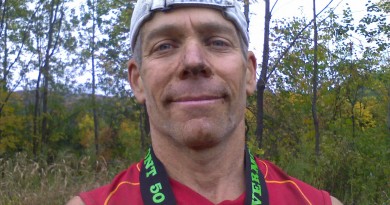Steve Snook – Reader Athlete
Age: 53
Residence: Newbury
Family: Wife, Annie Kitson; son, Tucker; daughter, Katie
Occupation: Environmental engineer
Primary sports: Running, telemark, and Nordic skiing
Steve Snook is a man who likes setting goals. After bagging all the 4,000-foot peaks in the Northeast, he decided to try something closer to home. The Vermont Department of Environmental Conservation employee and his wife attempted to take part in some form of activity in each of Vermont’s state parks over the course of 2013.
VS: Have you always been a runner?
SS: I was briefly a runner when I graduated from college and needed to do something for exercise. I did a few races in my 20s, but I didn’t stick with it and just ran for fitness. When I started working for DEC, I got exposed to more of a running culture, and in the spring of 2005, a colleague took me out on a three-mile loop in Waterbury. I couldn’t even run the whole thing. I had to take breaks to walk. But that fall, I did a half-marathon, and the following year, I trained up to a full marathon. That year, a bunch of people from work ran the marathon so there were a lot of people to do longer runs with. I’ve done the Vermont City Marathon every year since then, in part because it requires me to get in shape. I’m a goal-oriented person so it’s a good thing to have that out there.
VS: You haven’t stopped with marathons, though, have you?
SS: I did my first 50K in September of 2010, and the following month, I did the Green Mountain Marathon in the islands as a training run for the Stone Cat 50-miler in Ipswich, Massachusetts. I decided to run for seven miles before the marathon because my interest was in trying to run for five hours to prepare for Stone Cat. One problem with that is it made me a minute late for the start of the race so I had to run around dozens of spectators. The Stone Cat race has four loops of 12 miles, and that’s where I discovered that cold weather is really good for me. It’s a fun race because it’s a trail marathon and a 50-miler, and they’re totally flexible. If you sign up for the marathon and want to keep going, you can; and if you sign up for the 50-miler and want to quit after three loops, they’ll give you a 37½-mile time. My wife had taken our daughter to look at colleges, and they came out for the last lap. I felt so good that I think if they hadn’t been there I might have done an extra lap.
VS: You said you’re goal oriented. Have you tried to qualify for the Boston Marathon?
SS: I qualified for Boston once but that was the year the race filled up in eight hours, and I missed my chance. After that, they changed the qualifying times. My next age group would allow me to qualify with a 3:40. This year was my best year at 3:33 because the weather was cool, but I needed a 3:30.
VS: Speaking of goals, in 2013, you and your wife decided to do some activity in each of Vermont’s state parks. How did that go?
SS: We managed 45 of 52 (as of Dec. 21), but we had to put the project on hold because we’re in the process of moving. It started when we realized we could buy a state park pass for $25, so we each got one in our Christmas stockings. There are 52 parks, and we had a rule that we had to do something in each park. We’ve bicycled, cross-county skied, canoed, hiked, and camped. It’s been harder in places that don’t have day-use areas, so sometimes we’ve just walked through the campgrounds. Some park staff have been more obliging than others in that respect. In Maidstone, they let us drive close to the waterfront to canoe even though we weren’t camping there.
VS: Have there been some interesting discoveries?
SS: We went to North Hero when it was inundated by the floods and found two bucketed pot plants, which we photographed with the caption “invasive species.” We are also surprised to see a fence all along the path at Quechee Gorge. Other places like Bingham Falls aren’t fenced at all.
VS: Any hidden gems?
SS: We had some beautiful paddling off Knight Island, and we were surprised by how large Lake Carmi was. I’ve run and skied around Waterbury Reservoir, but for this project, we canoed there, which I’d never done. We enjoyed all the parks for different reasons.
VS: I understand you’ve also hiked the full Appalachian Trail, is that correct?
SS: I did it in bits and pieces. I did some as a Scout when I was in high school, and then between my undergraduate and graduate work, I went to Georgia and hiked about half the trail during the summer. Each year after that, I’d do another week. Ironically, my first section was a hike from New Jersey to the Delaware Water Gap, and the last section was from Pennsylvania to the other side of the Gap, facing where I had started.
VS: I’ve heard you’ve summited all the 4,000-foot peaks in New York and New Hampshire. Tell us about that.
SS: Actually, I’ve done Vermont and Maine, as well. I did all the New Hampshire ones in the winter, the Vermont and Maine ones in the summer, and New York was a mix. I finished the Adirondack 46ers this summer. I did a few with a friend from high school when we were in our 20s, and then we came back together years later and decided to try to knock off the full list.
VS: So you do winter as well as summer hiking?
SS: I’ve got a group of friends from college, and every winter we go for a three- or four-day weekend, typically in the Adirondacks so we can combine winter camping and backcountry skiing. We do routes like Marcy Dam, Avalanche Lake, and Johns Brook Valley. We’ve also done a few trips in the White Mountains, heading to Zealand Falls or Carter Notch Huts; and in good snow years, we’ve even gone to Pennsylvania. We all like to ski, and it’s an excuse to get together. The two friends who got this started used to head to the White Mountains every winter wearing wool clothing and using duct tape and klister instead of climbing skins. That’s how the tradition started.


